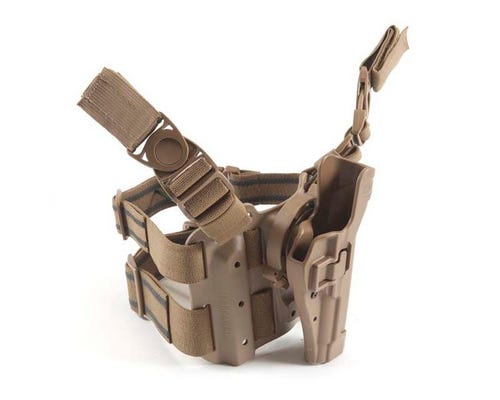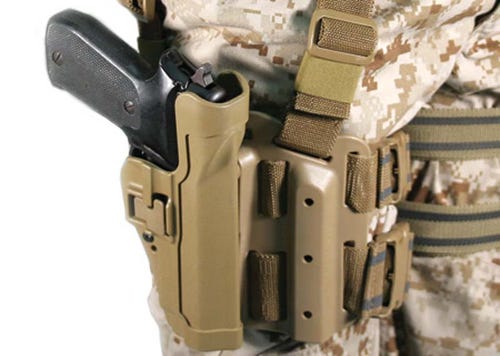source GAIA package: Sx_MilitaryTimes_M6201110109260316_5675.zip Origin key: Sx_MilitaryTimes_M6201110109260316 imported at Fri Jan 8 18:18:05 2016
Discuss:
The Marine Corps is ditching its 1980s-era nylon pistol holsters for new high-speed polymer gear used by U.S. special operators and law enforcement personnel, but the model chosen is the subject of a vigorous safety debate among tactical and professional shooters.
 Fielding of Blackhawk's SERPA Level 2 Tactical Holster will begin in November, with 27,455 of them distributed by April, according to officials with Marine Corps Systems Command in Quantico, Va. That's one for every 9mm M9 pistol in the Marine Corps' inventory. The pistols are typically carried in combat by officers and Marines whose jobs require them to work in confined spaces.
Fielding of Blackhawk's SERPA Level 2 Tactical Holster will begin in November, with 27,455 of them distributed by April, according to officials with Marine Corps Systems Command in Quantico, Va. That's one for every 9mm M9 pistol in the Marine Corps' inventory. The pistols are typically carried in combat by officers and Marines whose jobs require them to work in confined spaces.
 The SERPA's modular design will allow Marines to carry the pistol on their hips, chests or thighs depending on preference or mission, giving them a "battle-tested … system that will let them rapidly engage the enemy and transition between primary and secondary weapons," Maj. Amy Cahoon, project officer for the new USMC Holster, said in a news release.
The SERPA's modular design will allow Marines to carry the pistol on their hips, chests or thighs depending on preference or mission, giving them a "battle-tested … system that will let them rapidly engage the enemy and transition between primary and secondary weapons," Maj. Amy Cahoon, project officer for the new USMC Holster, said in a news release.
However, while the SERPA is more advanced than the M12 nylon holster it will replace, the product has been faulted by some firearm enthusiasts for what they say is a dangerous design flaw that can enable "trigger hooking." In some cases, if a shooter isn't careful when drawing the pistol, the trigger finger can slip onto the trigger and squeeze off a round. And that has caused injuries.
"I would think you would have the same worry regardless of what holster you are using," said Matt Rice, a Blackhawk spokesman. "With the draw stroke that Blackhawk works on, the finger is supposed to go outside of the trigger guard and line up exactly right when the pistol comes out of the holster."
In an emailed response to Marine Corps Times' questions, officials at MARCORSYSCOM said the holster was put through rigorous safety tests in July by Marines assigned to Quantico's Weapons Training Battalion. After giving the holster to Marines of varied pistol-shooting abilities, from expert to novice, Weapons Training Battalion concluded the SERPA holster is safe for issue, according to MARCORSYSCOM.
"We did not see a trigger-hooking problem," officials said. "We found the SERPA design allowed natural positioning of the trigger finger during the draw so that it was straight and off the trigger when drawn. … Weapons Training Battalion, our premier weapons trainers, oversaw the evaluation of the holsters and no safety concerns were identified by the users or the observers of the evaluation."
The commander of that unit, Col. Tim Armstrong, said the Corps is updating its combat pistol program and that training with the new holster will be addressed once changes are unveiled in the fall.
To draw a pistol from a SERPA holster, a Marine must disengage an "active retention system" by extending the trigger finger and pressing a button on the outside of the holster. This allows the Marine to quickly draw the pistol with a firing grip, ready to put rounds on target immediately.
But there have been instances in which pistol shooters have used too much force or pressed the release button with their finger hooked, causing it to slip onto the trigger and squeeze off a round as the pistol clears the holster, said Travis Haley, a retired force reconnaissance Marine and founder of Haley Strategic Partners, which trains special operations troops, elite police units and novice civilian shooters in basic marksmanship and advanced assault tactics.
"Anybody can get away with safe handling of a SERPA holster under a non-duress situation," Haley said. "But under stress, it becomes very dangerous because of what our body naturally does. … You are going to tense up and if you go for that gun quickly, especially in a transition situation, five out of 10 guys will have a problem."
Some will have trouble deactivating the retention system, Haley said. But in a worst-case scenario, a Marine could shoot himself in the leg or arm.
That's what happened in July to self-described outdoorsman and gear reviewer Tex Grubner. He captured the incident on video and posted it to the social networking site YouTube. The clip shows Grubner, of Metamora, Ill., standing inches from a paper target at an outdoor range. He quickly reaches for his .45-caliber pistol and "BANG!," the gun goes off. The bullet entered his thigh near the hip and exited above his knee, sparing him from grave injury.
While he faults himself for the negligent discharge, Grubner says it happened because he used too much force to press the release mechanism and hooked his finger onto the trigger. Like Grubner, others argue that negligent discharges with the SERPA are not the holster's fault, but the result of user error or poor training.
Still, Haley has banned students from using SERPA holsters in his classes. Some civilian shooting organizations have also banned them from competitions, including International Defense Pistol Association clubs.
Others have criticized the SERPA holster for the release button's open design. Dirt and debris can get wedged under it, said Kyle Lamb, a former member of the Army's 1st Special Forces Operational Detachment Delta and president of Viking Tactics, which trains military and law enforcement personnel in shooting skills.
"We have guys roll around in the dirt, and when they get up, they can't transition to their pistol. The pistol is stuck in the holster. I've seen it happen at least five times in my classes," Lamb said.
"I've put a whole lot of guys through training and I've never seen anyone shoot themselves with it," he added.
MARCORSYSCOM officials say they did not encounter that problem during testing.
MARCORSYSCOM declined to say which holsters were considered as it sought to replace the M12 holster, but said the SERPA was chosen because of its ease of use, comfort, ease of training and integration with gloves. Officials say they targeted the outdated M12 holster because so many Marines were paying for modern tactical replacements.
When issued this fall, the new holster will be available in right- and left-handed configurations and will come in coyote brown. The holster set will be issued with a quick disconnect adapter that connects to the main holster and allows it to be quickly snapped into place anywhere a Marine is carrying a mounting bracket. Three mounting brackets will be issued with one as part of a drop mount on the thigh, one a MOLLE/PALS mount and another a belt mount.
Staff writers Rob Curtis and Andrew deGrandpré contributed to this report.




